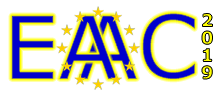Speaker
Description
Particle acceleration beyond the few-MeV level currently requires large infrastructures, due to the low frequencies (a few GHz) and relatively low field amplitudes (a few tens of MV/m in the meter-long structures) used in conventional accelerating structures. One of the scheme currently investigated to reduce the footprint of particle accelerators by several orders of magnitude is to use dielectric-loaded circular waveguides (DLW) driven by multicycle THz pulses, for which the operating frequency (100 GHz to a few THz) and field amplitude (up to a few GV/m) are expected to be much higher. A demonstration experiment of this acceleration scheme is currently investigated. The basic experimental principle would be to inject the 3-4 MeV electron beam from the S-band gun of the PHIL photoinjector into a DLW driven by a multicycle THz pulse, the Joule-class infrared laser from the LASERIX facility being a potential candidate for its generation. We study the feasibility of this experiment, especially looking at the design of the DLW, the requirements in terms of THz pulse properties, the integration into the PHIL beamline and evaluate the expected results through start-to-end beam dynamics simulations along the PHIL beamline with the DLW included.

